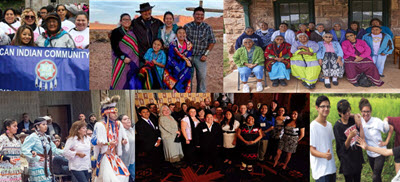Become a Patreon!
Abstract
Excerpted From: Libby Smith, Impact of the Coronavirus and Federal Responses on Indigenous Peoples' Health, Security, and Sovereignty, 45 American Indian Law Review 297 (2021) (270 Footnotes) (Full Document)
 COVID-19 has ravaged the United States since the first confirmed American diagnosis in January 2020. By December 2020, there were 19,663,976 diagnosed cases and 341,199 deaths attributed to the disease in the United States alone. In June 2021, a year and a half after the first American diagnosis, the CDC reported 33,283,781 total cases of COVID-19 and 597,195 deaths caused by the disease. Increased governmental regulations, economic shutdowns, and overwhelmed healthcare providers have impacted the lives of millions of people worldwide. Additionally, this pandemic has revealed long-standing systematic inequalities and injustices putting minorities at a greater risk of contracting COVID-19 and developing more severe cases of the disease.
COVID-19 has ravaged the United States since the first confirmed American diagnosis in January 2020. By December 2020, there were 19,663,976 diagnosed cases and 341,199 deaths attributed to the disease in the United States alone. In June 2021, a year and a half after the first American diagnosis, the CDC reported 33,283,781 total cases of COVID-19 and 597,195 deaths caused by the disease. Increased governmental regulations, economic shutdowns, and overwhelmed healthcare providers have impacted the lives of millions of people worldwide. Additionally, this pandemic has revealed long-standing systematic inequalities and injustices putting minorities at a greater risk of contracting COVID-19 and developing more severe cases of the disease.
In the United States, minority communities are disproportionately impacted by COVID-19. and African Americans are three times more likely to be infected than their white counterparts. and Alaska Natives are also more likely to contract the disease. The Centers for Disease Control and Prevention (CDC) reported that lab-confirmed coronavirus cases in American Indian and Alaska Natives were 3.5 times that among non-Hispanic white persons. In fact, the Navajo Nation, which encompasses parts of Utah, Arizona, and New Mexico, surpassed New York, the epicenter of the American outbreak, for per capita confirmed cases in May 2020. At the height of the pandemic, the Navajo Nation had 2,304.41 confirmed cases of COVID-19 per 100,000 people--the highest in the United States--while New York had 1,806 cases per 100,000 people.
The increased rate of transmission in Native American communities can be attributed in large part to historical inequalities in wealth and access to health care. The poverty rate for native Americans is greater than twenty-five percent, which is more than double that of the general population. The CDC explains that factors related to wealth, such as “reliance on shared transportation, limited access to running water, [and] household size” contributed to the rapid spread of coronavirus in tribal communities.
The heightened rate of both virus transmission and severe COVID-19 cases is also attributable to the lack of access to preventive medicine in NativeAmerican communities. People with preexisting conditions, such as cancer, diabetes, and obesity, are the most at-risk for developing severe cases of the disease. and Alaska Natives are more likely than the general population to have preexisting conditions; they are 4.6 times more likely to die of chronic liver disease and cirrhosis, 3.2 times more likely to die of diabetes, 1.8 times more likely to die of influenza and pneumonia, 1.5 times more likely to die of kidney disease, and 1.1 times more likely to die of heart disease. This increased rate of preexisting conditions among Native Americans puts them at a greater risk of developing a severe case of COVID-19, and the lack of adequate medical facilities available to tribal communities means that severe cases of the disease are even more dangerous. The Indian Health Service posits that “[l]ower life expectancy and ... disproportionate disease burden” in Native communities “exist perhaps because of inadequate education, disproportionate poverty, discrimination in the delivery of health services, and cultural differences.”
This Comment focuses on the systematic issues in the United States that led to the disparate impact of COVID-19 on Native communities and the long-term effects the disease will have on those communities. First, Part I discusses the Indian Health Service's inadequate funding, which contributes to a lower standard of medical care for AmericanIndians and Alaska Natives. Part II then examines the federal response to COVID-19 and the distribution of aid to AmericanIndian and Alaska Native tribes. Part III of this Comment analyzes the economic impact of COVID-19 on tribes and how decreased tribal income inhibits these communities from supplementing federal funds to fund tribal governments. Finally, Part IV concludes this Comment by challenging the federal government to formulate solutions for these pressing issues in NativeAmerican health, education, and poverty.
[. . .]
The ongoing COVID-19 pandemic has exposed many inequities in the United States, but none, perhaps, as profound as the treatment of Native Americans and Alaska Natives. The disparate impact the pandemic has had on Native communities revealed how decades of abuse and neglect have put Native communities at a disadvantage. However, through their responses to the COVID-19 crisis, tribes have shown their resilience, determination, and commitment to their communities. Self-determination policies have allowed tribes to begin confronting some of the inequities highlighted by the pandemic, but the United States needs to prioritize the expansion of tribal authority and recognize tribes as sovereign governments with responsibilities to their citizens. The federal government must provide tribes with the support they require to enable them to prepare for recovery and meet the needs of their citizens. To start, the federal government should fully fund medical care for tribal members, and it needs to prioritize NativeAmerican health, education, and poverty reduction. During the pandemic, tribes and Native communities have demonstrated their ability and willingness to dedicate their time, resources, and energy to strengthening their communities. The federal government must honor its trust obligation and give tribes the freedom and the resources to succeed.
Third-year student, University of Oklahoma College of Law.
Become a Patreon!


